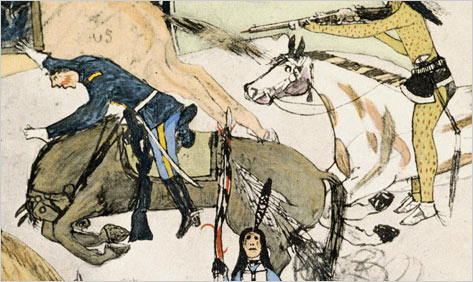Chief Crazy Horse

In the Great Sioux War of 1876-1877, one battle stands out in history; the battle of Little Bighorn in June of 1876 that resulted in the deaths of over 260 soldiers and scouts including General George Armstrong Custer.
The U.S. government promised in the Treaty of 1868 to set aside the Black Hills of Dakota for the Sioux people, but later broke their promise after the discovery of gold in the area. Custer lead an army detachment in the encounter of the Sioux and Cheyenne encampment at the Bighorn River and as a consequence Custer and troops were annihilated.
From The Killing of Crazy Horse
By THOMAS POWERS
[This] is what rode south toward the Rosebud on the night of June 16–17, 1876: thunder dreamers, storm splitters, men who could turn aside bullets, men on horses that flew like hawks or darted like dragonflies. They came with power as real as a whirlwind, as if the whole natural world—the bears and the buffalo, the storm clouds and the lightning—were moving in tandem with the Indians, protecting them and making them strong.
The government then took further action until in 1877 they succeeded in taking away the land promised to the tribes and also took the life of Chief Crazy Horse.
On Sept. 5, 1877 the Chief was jailed and stabbed. He died from a soldier officer’s bayonet in his back. According to Power’s award winning book, The Killing of Chief Crazy Horse, one witness named He Dog said that the guard “lunged twice with his bayonet.”
Sources: Barnes and Noble , Sioux Treaty , Chicago Tribune , CS Monitor